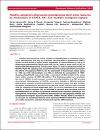PDGFRα depletion attenuates glioblastoma stem cells features by modulation of STAT3, RB1 and multiple oncogenic signals.

View/
Date
2016-06-17Author
Cenciarelli, CarloMarei, Hany E.
Felsani, Armando
Casalbore, Patrizia
Sica, Gigliola
Puglisi, Maria Ausiliatrice
Cameron, Angus J.M.
Olivi, Alessandro
Mangiola, Annunziato
...show more authors ...show less authors
Metadata
Show full item recordAbstract
Platelet derived growth factor receptors (PDGFRs) play an important role in tumor pathogenesis, and they are frequently overexpressed in glioblastoma (GBM). Earlier we have shown a higher protein expression of PDGFR isoforms (α and β) in peritumoral-tissue derived cancer stem cells (p-CSC) than in tumor core (c-CSC) of several GBM affected patients. In the current study, in order to assess the activity of PDGFRα/PDGF-AA signaling axis, we performed time course experiments to monitor the effects of exogenous PDGF-AA on the expression of downstream target genes in c-CSC vs p-CSC. Interestingly, in p-CSC we detected the upregulation of Y705-phosphorylated Stat3, concurrent with a decrement of Rb1 protein in its active state, within minutes of PDGF-AA addition. This finding prompted us to elucidate the role of PDGFRα in self-renewal, invasion and differentiation in p-CSC by using short hairpin RNA depletion of PDGFRα expression. Notably, in PDGFRα-depleted cells, protein analysis revealed attenuation of stemness-related and glial markers expression, alongside early activation of the neuronal marker MAP2a/b that correlated with the induction of tumor suppressor Rb1. The in vitro reduction of the invasive capacity of PDGFRα-depleted CSC as compared to parental cells correlated with the downmodulation of markers of epithelial-mesenchymal transition phenotype and angiogenesis. Surprisingly, we observed the induction of anti-apoptotic proteins and compensatory oncogenic signals such as EDN1, EDNRB, PRKCB1, PDGF-C and PDGF-D. To conclude, we hypothesize that the newly discovered PDGFRα/Stat3/Rb1 regulatory axis might represent a potential therapeutic target for GBM treatment.
Collections
- Biomedical Research Center Research [841 items ]

